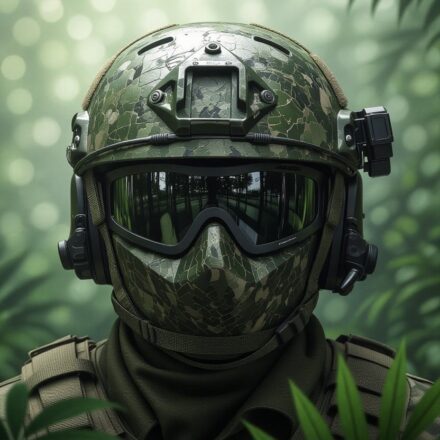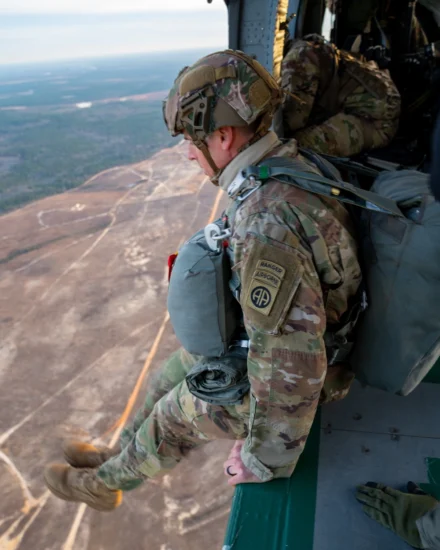Anduril’s launch of Eagle Eye during the recent AUSA Annual Meeting created quite a bit of discussion among those in the helmet industry as well as those who wear them. In response, we received this “State of the Industry” report from an inside who we will keep anonymous. The perspective is their’s and will hopefully serve to educate our readers.

The recent reveal of Anduril’s Eagle Eye helmet system at AUSA 2025 sparked a lot discussion regarding helmets and where the industry is with regards to what the user wants. Anduril did not present any performance specifications for the helmet. All we know now is that they are in collaboration with Gentex to optimize the helmet. At first glance, the helmet looks very close to the head with a relatively thin shell. Comments have been made that is essentially comparable to an exotic car prototype being revealed at a car show to spark interest in that manufacturer. But what is the rest of the helmet industry doing? Are they in step with what users are expecting? Have they made any progress in terms of protection over the last ten years or is it more of the same. This article discusses those topics by branch of service and manufacturer.
United States Army

The United States Army Next Generation Integrated Head Protection System is probably one of the most criticized helmet programs in the industry. This program dates way back to 2012 when it was originally called the Soldier Protection System. At that point in time, the helmet consisted of a shell and a fairly large ballistic applique to stop the small arms threat that was relevant to the Army. This was a very big and very bulky helmet that was competed between Gentex and Ceradyne. Note that Ceradyne was ultimately purchased by Avon so this became an Avon program. Ceradyne won the SPS program with a unique shell and rail design. The rail was a custom Ceradyne design that did not have any accessories ready to connect to it, unlike the Gentex/Ops-Core rail which is now industry standard. Around 2018, the two key domestic polyethylene providers had a break through in performance which provided protection from the small arms threat WITHOUT the need for the ballistic applique. To the Army’s credit, they scrapped the SPS program and released the IHPS program which drove down the areal density shell requirements to give the soldier a lighter more comfortable helmet. This was followed up by the NG-IHPS program which is now the formal program of record for the Army with both Avon and Gentex producing helmets likely through 2027 and a plan to onboard LTC in the near future as a third supplier.
With regards to performance, the NG-IHPS helmet is actually very impressive and offers more ballistic protection then the ECH at a lower areal density. It is a huge leap forward in terms of the weight to protection ratio and this achievement consistently get lost under other criticisms. What draws criticism from the user community is the rail, which nothing other than an enormous mandible attaches to, the visor, which has to connect to the NVG bracket, and the comfort and lack of stability of the liner and the chinstraps which need two hands to adjust. The liner is considered to be outdated, featuring Team Wendy Zap pads, which have been around for over a decade and a D30 crown pad. The liner pad design is driven by a 14fps requirement, which is double the impact energy of the SOCOM 10fps requirement. This requires a thicker stiffer pad which is partially the reason the liner is so uncomfortable. Furthermore, there is growing sentiment that the Army needs a high cut version of this helmet system.
These concerns have not fallen on deaf ears. The Army has asked industry to provide new liners to increase comfort and is considering the 10fps requirement instead of 14fps. In addition, the Army has requested custom pads from industry for hot and cold weather pads. Furthermore, the Army has requested updated rail designs from both Avon and Gentex to allow for better integration of accessories such as flashlights, cameras etc.
At AUSA, Gentex pulled out all the stops and show cased what the NG-IHPS helmet could be with a new rail, new liner, new chinstrap, new visor, integrated communication headset through rail arms and even a version of the helmet featuring the Gentex RaiLink Power and Data System. Unfortunately, it was only shown to key customers like program managers.
Marine Corps
The Marine Corps recently competed the Integrated Helmet System between Galvion and Gentex with Galvion being down selected as the awardee. This of course has led to a protest from Gentex which is typical of the Galvion / Gentex rivalry, more on that later. The IHS helmet also features small arms threat protection but to a lesser degree than the NG-IHPS helmet. It also features a power and data system, which in this case may be the Galvion Cortex system after this winds its way through the protest process, which can take months and even years.
SOCOM
The Program Management for SOCOM has driven innovation in the head protection space, more than any other government organization, period. They were the first Government organization to full adopt a high cut polyethylene helmet with rails and continue to drive down weight and drive up performance using a five year cycle of competition for the Family of Tactical Headborne Systems. Gentex is the incumbent provider of this helmet, having beat out Galvion in 2019, which of course was followed by a Galvion protest. Gentex and Galvion have competed directly against each other on helmet programs and in court more than any other pair of companies in the industry. They have competed against each other for every major helmet program in North America and Europe. They recently went to court for violations of intellectual property with Gentex winning a decision that Galvion had indeed violated Gentex IP with their version of the helmet rail. Currently the two companies have both submitted helmet systems for the current FTHS competition which should be downselected to a winner in the first quarter of 2026. Both helmets systems are elite in terms of the weigh to performance ratio, offering 9mm protection at an areal density of roughly 1 pound per square foot.
Ironically, Team Wendy did not compete for FTHS in 2019 and has declined to compete for FTHS in 2025. Team Wendy is a division of AVON, and the AVON mantra of “simpler is stronger” may have cost them this opportunity as they were not willing to tool up the required four sizes of shells. Team Wendy only has two sizes of shells while Galvion has 5 and Gentex has 4.
SOCOM continues to pace the industry not only with the best helmet systems available but also technology upgrades such as Gentex’s RaiLink Power and Data rail system which has been purchased by the Army Special Missions Unit.
Overseas
The largest overseas program was competed in 2024 and awarded in 2025 by the NATO Support and Procurement Agency. Again, Galvion and Gentex were the two main competitors for this program and each company was awarded different tranches of the tender. Galvion has an inside edge on the rapidly growing European Helmet Market now that they are producing helmets in Poland while Gentex continues to produce helmets for Ground applications solely in the United States.
Anduril
This brings us back to the Eagle Eye Helmet System. Anduril took a “first principles” approach towards their new helmet design, rejecting industry knowledge to bring something lighter and higher performing to the market. This might make sense in a software context where the rules of physics are not constraints. Every branch of service has improved their ballistic protection to weight ration substantially over last ten years and in some cases reduced their weight burden by 50% while still offering the same levels of protection. Industry has provided these customers what they asked for and then some.
With regards to Visual Augmentation Systems, if you are lucky enough to use the L3 F-PANO or Elbit ENVG-B, you will experience the very best of what the VAS industry has to offer and it is incredible. The thermal outline mode is just one of the features that these production tubes offer now that will impress even the most jaded user and it is a real thing that L3 is selling now. This is one of the key difference between Eagle Eye and the current systems that it says it outperforms. L3 and Elbit just don’t feel the need to go on the Joe Rogan Experience to discuss their technical breakthroughs.
So then, who is the customer for Eagle Eye? It is not a program of record. Neither Army, USMC or SOCOM have asked for it and none of them are funding it. However, they are buying NG-IHPS, FTHS, F-Pano and ENVG-B because those programs have delivered on what the user community has asked for. And where the programs have fallen short (IHPS Liner for example) the program offices have reacted to improve their systems. The customer for Eagle Eye is the general public, and what’s for sale is shares in Anduril when and if they become publicly traded. Anduril is not creating a system to benefit the user, they are creating a system to draw interest in their company. Joe Rogan has never purchased or influenced a Government Program Acquisition. This is not intended to answer the mail for the user community but rather spark the interest of the general public.
You can skip to the end and leave a response. Pinging is currently not allowed.
Read the full article here



